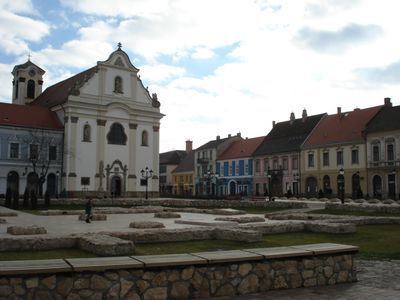Time zone CET (UTC+1) Area code(s) 27 Local time Wednesday 1:22 PM | Postal code 2600 Population 33,475 (2013) | |
 | ||
Weather 16°C, Wind W at 8 km/h, 66% Humidity University Apor Vilmos Catholic College Points of interest Assumption Cathedral - Vác, Püspöki Palota, Tragor Ignác Múzeum, Tragor Ignác Múzeum, Inundation Area of Vác | ||
Vác ([ˈvaːt͡s]; German: Waitzen; Slovak: Vacov; Yiddish: ווייצען) is a town in Pest county in Hungary with approximately 35,000 inhabitants. The archaic spelling of the name is Vácz.
Contents
- Map of VC3A1c 2600 Hungary
- Location
- Modern Vc
- History
- Ethnicity
- Religious denomination
- Twin towns Sister cities
- References
Map of V%C3%A1c, 2600 Hungary
Location
Vác is located 35 kilometres (22 miles) north of Budapest on the eastern bank of the Danube river, below the bend where the river changes course and flows south. The town is seated at the foot of the Naszály Mountain in the foothills of the Carpathians.
Modern Vác
Vác is a commercial center as well as a popular summer resort for citizens of Budapest. The cathedral, built 1761–1777, was modelled after St. Peter's Basilica in Rome. The episcopal palace houses a museum for Roman and medieval artifacts. The city is also known for its 18th-century arch of triumph and for its beautiful baroque city center.
History
Settlement in Vác dating as far back as the Roman Empire has been found.
Bishops from the Roman Catholic Diocese of Vác were influential within the Kingdom of Hungary, with many serving as chancellors or later becoming archbishops.
On 17 March 1241, due to the attack of Mongols the whole population was slaughtered, Vác ceased to exist and Mongols set up camp there. After the departure of the Mongols Vác was rebuilt and inhabited by German colonists.
The town was conquered by the Ottoman Empire in 1541. During the Habsburg Monarchy's wars against the Ottomans, the Austrians won victories against the Turks at Vác in 1597 and in 1684.
During the Hungarian Revolution and War of Independence of 1848-49, the Honvédség routed the Austrian forces stationed in the city after a major battle (April 10, 1849); the Second Battle of Vác ended in Russian victory (July 17).
During World War II, Vác was captured on 8 December 1944 by Soviet troops of the 2nd Ukrainian Front in the course of the Budapest Offensive.
See also:
Ethnicity
Religious denomination
According to the 1910 census, the religious make-up of the town was the following:
Twin towns — Sister cities
Vác is a twinned with:
